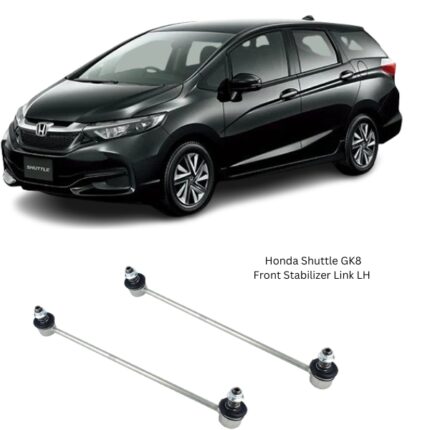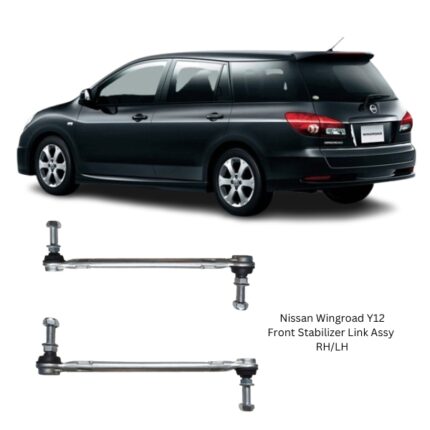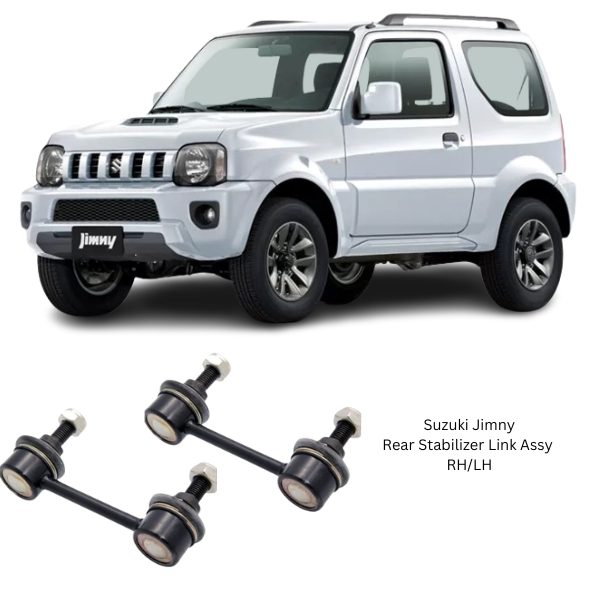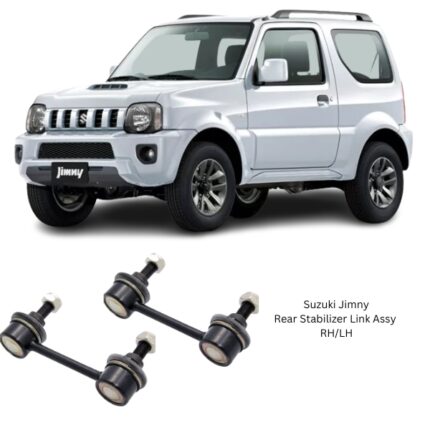Get Suzuki Jimny Rear Stabilizer Link Assy RH/LH 20470-AE001 in Kenya
The Rear Stabilizer Link Assembly, applicable to both the Right-Hand (RH) and Left-Hand (LH) sides, is a vital suspension component designed to connect the rear stabilizer (anti-roll) bar to the suspension system. Although small in size, its contribution to vehicle handling, balance, and ride quality is considerable. It plays a pivotal role in limiting body roll, improving cornering stability, and maintaining proper weight distribution across the rear axle.
The rear stabilizer link assembly ensures that when one rear wheel encounters a bump or dip, the force is partially transferred to the other wheel. This interaction promotes vehicle stability and keeps the car level, enhancing both safety and comfort, especially under heavy cornering loads or when driving on uneven road surfaces.
Purpose and Functionality
The rear stabilizer link acts as the connection between the rear sway bar and the suspension arms or shock absorber assemblies. By creating this mechanical linkage, it enables the sway bar to distribute movement across the vehicle’s rear axle, minimizing excessive side-to-side body movement.
Key Functional Roles:
-
Reduces Rear Body Roll
Transfers vertical suspension movement between left and right sides to resist leaning and swaying during sharp turns. -
Enhances Rear-End Traction
Helps both rear wheels maintain better road contact, especially during fast lane changes, cornering, or on rough terrain. -
Improves Handling Response
Contributes to a balanced feel between the front and rear suspension, enhancing overall vehicle responsiveness. -
Supports Suspension Integrity
Works in conjunction with other components like the rear shocks, struts, and bushings to reduce load stress and prevent premature wear.
Design and Construction
The Rear Stabilizer Link Assy RH/LH is engineered for strength, flexibility, and endurance. Despite its compact form, it must withstand dynamic stress and continuous flexing over varying road conditions. It consists of a solid or tubular shaft fitted with ball joints or bushings at either end.
Primary Components:
-
Ball Joints or Rubber Bushings
Provide articulation and reduce friction. Ball joints offer superior movement and durability compared to rubber bushings. -
Metal Shaft (Rod)
A rigid bar made from hardened steel or alloy connects both ends. Its shape and length vary based on the suspension design. -
Protective Boots
Rubber or polyurethane boots cover the joints, protecting them from dust, moisture, and road contaminants. -
Threaded Studs or Bolts
Located at both ends for secure connection to the sway bar and suspension arm or shock assembly.
Materials Used:
-
High-Tensile Steel or Forged Alloy
Provides strength and resistance to bending or fatigue. -
Corrosion-Resistant Coating
Zinc-plated or phosphate-treated to resist rust and oxidation from road salts and water. -
Synthetic Rubber or Polyurethane Seals
Offer weather resistance and durability in extreme temperatures.
Performance and Driving Benefits
A fully functional rear stabilizer link assembly ensures optimal suspension balance and enhances the driving experience.
-
Minimized Rear-End Sway
Crucial during sharp turns, emergency maneuvers, and high-speed cornering. -
Enhanced Straight-Line Stability
Reduces the chance of lateral movement or vehicle “tail wiggle,” especially when driving over uneven or bumpy terrain. -
Balanced Load Distribution
Supports even pressure distribution across the rear tires for improved wear and stability. -
Improved Ride Comfort
By absorbing shock forces and limiting unnecessary body movement, the rear suspension operates more smoothly. -
Predictable Handling in Adverse Conditions
Important during rain, gravel, or uneven road surfaces where traction is challenged.
Signs of a Worn or Failing Rear Stabilizer Link
Rear stabilizer links are subject to continuous flexing and stress, which can lead to wear over time. Failure to address worn links can compromise handling and increase stress on other suspension components.
Common Symptoms Include:
-
Clunking or Rattling Noise from Rear Suspension
Especially over speed bumps, potholes, or rough roads—indicating play or looseness in the joints. -
Increased Rear Body Roll
More noticeable lean during cornering, especially if one side is worn or disconnected. -
Poor Handling and Unstable Ride
A disconnected or broken link can lead to unpredictable vehicle movement at the rear. -
Visual Inspection Reveals Damage
Cracked boots, rusted joints, bent rods, or loose bolts indicate wear. -
Uneven Tire Wear
A result of compromised rear suspension alignment and behavior.
Installation Overview
The Rear Stabilizer Link Assembly is typically a bolt-on component that can be replaced with basic tools. However, accuracy during installation is essential for proper function.
Installation Steps:
-
Lift and Secure the Vehicle
Raise the rear of the vehicle safely and support it with jack stands. -
Remove the Wheel (if necessary)
Gain access to the link ends at the sway bar and suspension mount points. -
Unbolt the Old Link
Use the appropriate tools to remove the fasteners. Penetrating oil may be necessary if corrosion is present. -
Inspect Mounting Points and Sway Bar
Ensure there’s no damage to the attachment points or surrounding bushings. -
Install New Link
Position and tighten the new link to manufacturer torque specs. Ensure the correct orientation (RH or LH). -
Check Suspension Movement
Lower the vehicle and test drive to verify that the clunking noise has been resolved and handling has improved.
Note: For best results, replace stabilizer links in pairs—even if only one side is faulty—to maintain uniform suspension behavior.
Maintenance Tips
-
Inspect Regularly
Visual inspection every 10,000–15,000 km is advisable, particularly if you drive on rough terrain or carry heavy loads. -
Protect Against Contaminants
Ensure dust boots are intact. Moisture and debris entering the joint drastically reduce its service life. -
Avoid Overloading the Vehicle
Excessive rear weight increases stress on suspension components, accelerating wear. -
Listen for Changes in Ride Quality
Pay attention to handling inconsistencies or new noises—early symptoms of link failure.
Importance of Timely Replacement
Ignoring rear stabilizer link wear can lead to:
-
Reduced handling safety
-
Tire misalignment and wear
-
Added stress on the sway bar and rear shocks
-
Overall deterioration of rear suspension geometry
Replacing the Rear Stabilizer Link Assy RH/LH as soon as issues arise is an inexpensive yet impactful way to restore driving comfort, stability, and confidence—particularly when driving at speed, towing, or navigating hilly terrain.
Follow us on Facebook for more parts.





Reviews
Clear filtersThere are no reviews yet.